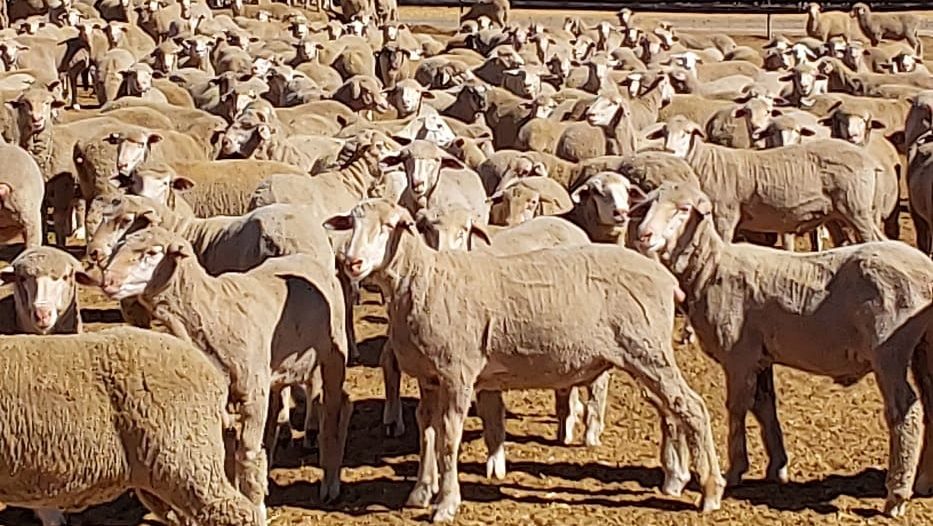
Merino lambs in the Glenpadden Farms feedlot In Western Australia.
WESTERN Australian lamb lotfeeder Geoff Bilney prefers non-mulesed Merinos over the more commonly mulesed lambs and can see a day when lamb processors will demand that lambs not have the breech modification.
During an Australian Wool Innovation ‘Making money out of wool’ webinar on Tuesday, Mr Bilney was asked if he would pay a premium for non-mulesed Merino lambs.
“What do they say, there is no such thing as a premium, only a discount?
“Yes we would, and it will come where the processors say to us ‘they can’t be mulesed,’ and that’s probably that something that people can actually all do, even if it’s just their wether lambs,” he said.
“I mean they’ve got to get them through one spring where there is a problem maybe with their lambs getting a little dirtier.”
He said some of the Merino lambs come in with a tail strip and apart from that look non-mulesed.
“It will come; at some stage one of the markets is going to decide that there is an advantage for them by saying that none of their lambs have been mulesed, and so the expectations will come.
“It would be better for us to … and that’s maybe something that the industry actually looks at trying to shift to before someone asks for it and actually say ‘well they’re not mulesed’, the problem is not there,” Mr Bilney said.
Mr Bilney said because most Merino lambs have been mulesed through cradles they inherently had a higher rate of arthritis and he would like to see producers vaccinate against this when marking.
“That would probably be the major thing that we would love to see.”
Mr Bilney said lotfeeding lambs is a major part of the Glenpadden Farms business near Kojonup. The feedlot is antibiotic and hormone free, producing lambs that go into WAMMCO’s North American market.
He said about 30 percent of the lambs going through the feedlot were Merinos and their carcase conformation was acceptable to processors after feeding.
He said processors nowadays don’t sell just carcases, they sell lamb broken up carcases or cuts.
“They (Merinos) are going to perform just as well in a processing sense as a crossbred lamb.
“But people need to know there is Merinos and there is Merinos,” Mr Bilney said.
“There are some Merinos whose genes for growing wool is extremely strong and those guys (breeders) are probably going to need to maybe put a little bit more emphasis on getting themselves to a carcase that is going to be acceptable.”
The feedlot’s Merino lamb purchasing criteria includes an individual liveweight of 42kg.
“Everything is here for a minimum of six weeks, that will allow us to get something very very close, maybe a little bit over, a 25kg carcase out in six weeks and maybe in the mid-90s percentage wise of lambs making that requirement.
“So it’s pretty much, the Merino is OK and there is an outlet for him,” he said.
“With the change in the (dentition) definition of lamb the June to July period has a window that requires livestock, most of the first cross lambs at that point of time are gone and the Merino is going to be ideally suited to actually fit in there and fill that window.”
Mr Bilney said the feedlot would be comfortable buying a 13 month-old lamb in June-July, when the percentage of June drop lambs that would have broken their permanent incisors is not huge.
“It’s manageable in the system.
“So basically there is an outlet for your livestock, just the specifications you need to change to are higher.”
The feedlot did not do any backgrounding so lambs have to be ready to go onto feed when it arrived at Glenpadden, he said.
“People are going to have to change to be able to achieve those weights – they are higher than the weights for the boat – but there is an outlet.”
Mr Bilney said WA processors last year processed 660,000 sheep more than the year before and WAMMCO is looking at increasing its kill by 2000 lambs a day at some stage next year and they will need livestock.
“In March last year is when we believe the tide changed from people being unable to get rid of their livestock to the point where, whilst the price was disappointing, people were able to move their livestock.
“So I think the worst is basically over in the sense of being able to find processing or feedlot capacity to take your lambs,” he said.
“There is a glut at the moment and I think that was brought about by people thinking that there was going to be a shortage, so no one actually planned the movement of their livestock over this next six to eight weeks.
“But there are places for your livestock to go and I think that is as important for people to know that there is an outlet and that there is a place for them to move product.”
Mr Bilney said a good carcase was achievable from a Merino lamb, but some Merino studs would need to put more emphasis on carcase quality.
“In the sense of, some of them have extremely high wool growing genes, which is fantastic if you want to be a wool grower, but I think everybody will acknowledge that meat is now actually a significant part of a sheep enterprise, even a wool growing enterprise.”
Mr Bilney pointed out that the grand champion lamb in Lambex 2024 feedlot competition was a Merino when assessed for eating quality traits such as intramuscular fat.
“The Merino is OK and there is somewhere for him to go to.”
But Mr Bilney said Merinos had lower growth rates and there were 3-4 Merino studs that he would be apprehensive about sourcing lambs from.
“Just because their wool growing gene is so strong.
“We had one stud in particular that their first cross lambs are really tough, because as a first cross lambs they still just want to grow wool,” he said.
“The vast majority of them are OK; we are talking about a few studs that really just need to accept a bit more of a bigger carcase and maybe just a little bit less of the wool growing gene.”
Mr Bilney also pointed out that Merinos will yield a skin value, whereas there is none for crossbred lambs.
“The Merinos we can shear and get an income from their wool, so when you add it all up and down there is not a lot of difference between a first cross lamb and a Merino running through a feedlot.
“We get a skin value, we get wool,” he said.
“There are crossbreds we would shear if it was viable to do so, but I think there is about $4 loss per head for us in shearing crossbred lamb at the moment, but once we get into May we will have to shear all of our lambs.”
He said there is a lot of negativity in the WA industry, but lamb prices now are very close to pre-COVID levels when everyone was looking at running additional sheep.
“So there just needs to be a bit more enthusiasm and people will realise that there is somewhere to go provided you meet the specifications.”
He said although research indicated shearing did not make a difference to lamb growth rates, the feedlot shears Merinos once they have a 25-30mm staple length and they “just explode.”
“It makes management way easier as well; you can see exactly what you’ve got.
“If we could breakeven (with wool income) or maybe a little bit of a loss on our crossbreds we would shear them because of the bounce that we get,” he said.
“At the moment the bounce is not worth $4-5 a head, so we are not shearing crossbred lambs.”
Merinos and crossbred are run together, although incoming lambs are kept in their groups to maintain the social structure of the mob, Mr Bilney said.
“We don’t want Merinos until after the first of January because they just don’t have the maturity and they just need a little bit of tough love, a bit of dust, they have to work for their feed before we will take those in.”

Another issue with mulesed carcases is the skin often tears around the edged of the mulesed area requiring more trimming. This usually creates more being discarded, leaving slightly less weight in the carcase.
The sheep and lamb industry has no means of tracing the mulesing status of our meat products. Meat & Livestock Australia, the Integrity Systems Company and Sheep producers Australia have left our industry vulnerable, with our overseas custom lacking traceability and transparency of our products.
Great article by the way. I totally agree with your view re high fleece weight animals verses better carcase with a less fleece weighted lamb.
The Merino is dragging the chain on carcase and losing market share to other breeds. Now is a really good time to make a change from a wool-driven flock to something with more genetic meat and fat. There is just so much to gain; more fertility, more lambs to sell and better lambs out of ewe lambs. Get these right and you won’t look back 100 percent.
That chain is very heavy for some Merinos.